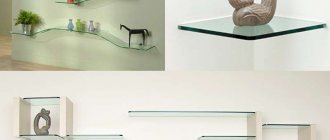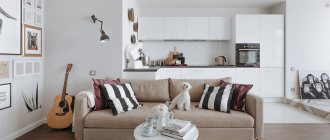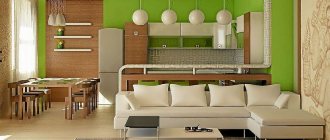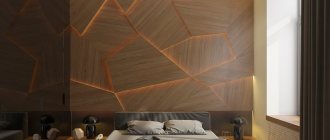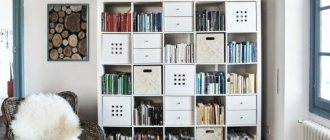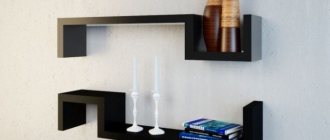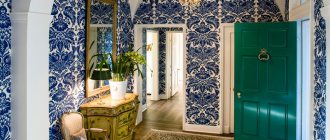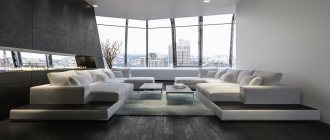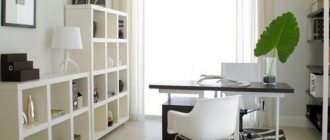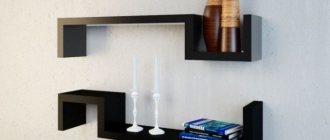When decorating residential interiors of apartments and private houses, one rarely does without laminate. This type of flooring is confidently gaining popularity due to its technical, operational and, of course, decorative qualities. Alas, not everyone has artistic taste. Therefore, we will use the tips and recommendations of designers on how to use laminate in the interior and at the same time create the right atmosphere in any room.
What is the secret of the popularity of laminate
A multilayer material with a high-density wood fiber base has won consumer recognition in just two decades of presence on the domestic market. And this is explained by the following set of advantages and advantages over other products of a similar purpose:
- Versatility. Based on its technical properties, laminate can be selected for installation in any room.
- Durability, moisture resistance, strength, wear resistance. The consumer will find out these parameters at the selection stage, having decided on the class of the product being purchased, its thickness, the method of fixing the lamellas and other nuances. Consequently, it is possible to select the optimal floor covering for any load without overpaying.
- Price is not the main criterion for choosing laminate flooring. But to be fair, we note that the consumer is offered an assortment from budget models to premium collections.
- An abundance of laminate options of various textures, reliefs, imitation, colors.
- Easy to install yourself.
Designers also have a special attitude towards the material in question. After all, modern laminate, in addition to its usual use, is a good solution for decorating a section of a wall or ceiling. Lamels without a chamfer are assembled into a monolithic surface under some natural material, with a chamfer - into a believable imitation of expensive parquet.
The slats, at will or according to the design project, can be laid out in straight lines, diagonally, or in a herringbone pattern. Not long ago, collections of laminated products in the form of square tiles began to appear. They amaze with the abundance of stylish designs, patterns, imitations, and are a godsend for interior decorators.
How to choose
When choosing a laminate, you first need to decide on the appropriate quality and technical characteristics: product class, its geometric parameters, thickness, base material, type of locking connection, environmental friendliness, moisture resistance. In this case, the nature of the room, operating features and expected loads on its finishing floor covering are taken into account.
Color examples
It is also very important to decide on the manufacturer of the purchased products. Now that you are confident that the selected laminate model is guaranteed to be suitable for a particular room in terms of quality indicators, it’s time to decide on the decor of the products.
It is the spectacular appearance, a certain texture and color scheme that make it possible to break out of the usual monotony, to combine all the elements of the decor into a single ensemble that corresponds to a certain style and creates a certain mood. It is not necessary to have impeccable artistic taste and understand the intricacies of design art.
It is enough to embody your concepts of coziness and comfort in the created interior, taking into account the options for playing colors, favorable combinations of shades, some rules of interior design and, of course, advice from professionals. Next, we will consider and study some recommendations from practicing masters.
Dark laminate floor
A dark floor in the interior is one of the signs of a noble classic style. The main thing is not to make it dull and gloomy due to the wrong choice of unsuccessful complementary details. Therefore, you will have to take care of a scrupulous selection of color schemes for other surfaces of the room, furniture, accent items and other accessories.
On a note! Even budget dark laminate looks more expensive and more impressive than light samples made from the same material.
The most common and popular dark shades: brown and chocolate - look expensive, create a feeling of comfort and warming energy; black – very extravagant, is a good background for interiors in modern styles; dark gray is a fairly cool color that simultaneously relaxes and induces a state of aloofness.
To prevent a setting with dark floors from merging into a continuous faceless mass, the flooring requires contrast and bright accents that adequately play off the dark background.
Here are some combination options:
- A win-win combination with dark floor finishes in coffee beige colors. The atmosphere of such an interior will always seem cozy.
- The black and white combination is ideal for strict minimalist styles. A few beige shades in such an interior will add soulfulness and emotionality, the presence of geometric patterns will make it dynamic.
- Bronze and gold against the background of a dark brown laminate are a solemn aristocratic classic.
- Orange shades enhance the cheerful message of the overall atmosphere.
- The colors of the green palette in combination with light yellow accessories will bring freshness and naturalness to the decor.
- The mystical duet of brown and purple colors will fill the space with mystery.
- Shades of turquoise and sea wave set visitors to the room for relaxation and rest.
In addition to its decorative function, a dark floor sometimes serves as an optical illusion, expanding or contracting the space visually as a result of certain design techniques. Using laminate in dark tones, interiors can be created from classic to bohemian or austere. It is very important to reveal all the advantages of this color and not lead it into the shadows.
Stylistic directions
Laminate has become widespread among people due to its wide range of colors and textures. The color of the flooring also depends on the style of the living room. Thus, classics are characterized by dark colors, while ethnic and modern styles are characterized by light colors. It is possible to decorate the living room in other stylistic directions.
- Country. The American ranch is characterized by laminate flooring in dark colors. Its design should resemble a plank floor.
Bright shades
There are no restrictions for creating a floor finish in bright colors and using eye-catching designs. In this case, it is important not to disturb the overall atmosphere of the room and remember its main purpose. For example, all colorful and flashy solutions will distract attention and distract you when working in your personal office or in your home library.
You should also avoid visual tension from the resulting surface and the competition of its design with the rest of the surroundings. The resulting coating can be one color or stand out in original contrasting combinations. The design project of such a floor should take into account the size of the lamellas, the choice of successful partner colors, and the frequency of repetition of the pattern or accent.
Winning options: checkerboard laying of multi-colored laminated tiles, the use of sequential installation with the effect of a three-dimensional pattern, laying a monolithic coating of the selected color.
Gray laminate floor
The main advantage of a gray floor is its ability to fit harmoniously into interiors of various styles and look noble in them without attracting attention. This color can be considered the most diverse. Its shades range from an ash-pearl palette to dark charcoal options. And if a dark floor can act as an accent or background, then light gray gives a feeling of cool freshness and constant movement of air flow.
Carefully! Carefully select the color of the walls in rooms with gray laminate flooring. It is quite capricious in a duet with cold colors.
Emotionally, monochrome gray shades give a feeling of confident balance, relieving accumulated tension. Therefore, such a floor is in demand in the bedroom area and in the living room. On the practical side, gray coating is suitable for corridors and hallways.
Create a style
For living room floors, the design of the laminate surface layer is extremely important. Leading manufacturers have launched the production of a wide variety of types of material, differing in texture and color.
The living room can have the most exclusive design overall, with a bold mixture of styles and colors. However, it is recommended to choose laminate in the interior of the living room closer to the classic version, that is, imitating the pattern of wooden boards, planks, parquet plates.
This approach can be explained by the following consideration: the task of the floor is not to distract from the main design, but to provide a background for it. A wooden surface is a universal option for an ideal floor.
As a last resort, you can lay a smooth, plain board that has no texture. Floors with imitation stone, ceramic tiles or jute fabric in the living room are unacceptable.
There are no restrictions regarding color shades when decorating the floor in the living room. Light floors are acceptable, even very light, dark, golden brown - any shades of wood. The color scheme of the floors can match the overall tone of the interior, but should be slightly different from the furniture.
The color of the floor can also form a contrasting background for other design elements. Treat the selection of laminate as responsibly and thoughtfully as possible: then the floor in the living room will last a long time and provide the room with the necessary style and level of status.
White laminate in the interior
White color is always fashionable, it is always in demand, just like black. This is a successful option for use in a classic interior. With bright accents and a subdued surrounding palette, it pairs perfectly.
A light laminated floor adjusts the size of the rooms, makes their atmosphere light and the ambience refined, it contrasts well with stylish dark furniture, and goes well with the rich finish of the wall surfaces. From classic to high-tech, white laminate flooring expands the boundaries of rooms and fills them with light.
Where can I lay it?
This is a truly versatile material. It can be installed in bedrooms, living rooms, children's rooms, hallways and kitchens.
They also began to actively install them in country houses, including seasonal residences. But this is risky, since the guarantee only applies to finishing in residential areas with a constant temperature and slight fluctuations in humidity: from 30% in winter to 60% in summer.
A seasonal country house is not heated for most of the cold season, and, naturally, the floors in it either heat up or cool down. Such climatic disasters are not useful for finishing.
Today, the material can also serve as an original wall decoration. The planks are fixed directly to the base using silicone glue and pins (nails without heads) or to a wooden sheathing. Of course, such cladding should not be used near water sources, as a kitchen apron or as wall decoration in the bathroom.
Heavy objects are not attached only to the wall trim. Their reliable installation will be ensured by fastening elements that pass through the laminate and are fixed in the load-bearing part of the wall.
Laminate on the wall
If earlier the photos of fancy interiors with laminate on the walls caused surprise, today this is a common design practice. For such applications, some manufacturers already offer special collections of laminates complete with system fasteners.
Advantages of this application:
- The ability to create an original surface thanks to a wide variety of colors, textures and imitations of the produced laminate.
- Durability of lamellas.
- Practicality of the material, easy cleaning from possible contamination, the ability to replace individual elements.
- Obtaining a multifunctional finish with sound and heat insulation properties.
Helpful information! During operation there is no mechanical load on the wall covering. Therefore, you can save money when purchasing laminate by choosing products with low wear resistance and low thickness.
According to the design idea, they use the design in one color or combine finishes from different collections, lay the laminate in different ways. At the same time, remember that they use the laminated coating in doses. It should occupy one wall or a section of it (when zoning the space). Otherwise, when the floor and walls are covered with the same laminate, you may get the effect of being in a closed box or a forester’s hut.
Optimal load class
The class of laminate determines strength and durability; accordingly, you need to select products based on their wear resistance and indoor loads. So, which class should you choose for laminate flooring in the living room? For residential premises, the market offers floor coverings of 31-34 classes. Definitely a good laminate for a class 32 living room - it is characterized by an optimal combination of price and quality.
It is also possible to use laminate class 33 or class 34 slats if the buyer liked a specific decor, but still there is no need to overpay, given that at home it will not be possible to put such a strong load on the laminate in the living room. In terms of board thickness, it is quite enough to buy standard 8 mm, but if the subfloor has unevenness or you need to get it level, for example, with tiles, then it is recommended to lay 10-12 mm dies.
Laminate on the ceiling
The advantages of ceilings designed using laminated elements are similar to the option of using it on vertical surfaces. In addition, it can be noted that such finishing, thanks to reflected light, helps to significantly improve the illumination of the premises.
The installation method leaves the owners a choice - to make a sheathing or a full-fledged frame for fixing individual lamellas to it. In the second case, it is easy to place the necessary communications under the finishing. Laminate can be glued to a perfectly flat ceiling.
In various rooms
And now a little about how to choose and profitably use laminate flooring in rooms for various purposes. The choice of the shape and size of the lamellas, their color and imitation option is made taking into account the size of the room, the degree of its illumination, the location of openings, furniture and prominent furnishings.
Bedroom
To make staying in this room conducive to maximum relaxation and rest, it is advisable to complement the furnishings with laminated wood-look products. Such finishing of the floor and at the head of the bed (on the wall) will add an additional feeling of natural warmth to the atmosphere. How the finish will look is largely determined by the choice of wallpaper and lighting options.
Kitchen
Laminate in the kitchen easily replaces ceramic tiles both on the floor and in the apron area. By using different models, the necessary zoning of places for cooking and eating is carried out. Often slats are used to decorate the wall around the dining table or seating area. We should not forget about the special requirements for kitchen decoration. The purchased laminate must have sufficient protection against abrasion and moisture resistance.
Hallway
Laminate of a high wear resistance class, which is not afraid of moisture, successfully competes with linoleum, ceramic tiles and porcelain stoneware. It is also possible to use a combination of these finishing materials to highlight the shoe change area and extend the corridor. At the entrance door, laminated wall decoration (not up to the ceiling) is appropriate, which retains its attractive appearance for a long time.
Balconies and loggias
The owners try to arrange balconies and closed loggias protected from the street no worse than other rooms of the apartment or house. Stylish wood finishes are appropriate here and help organize a comfortable space. Laminate can be placed on all surfaces of the balcony. Small sconces are adjacent to it advantageously. When choosing products for finishing, pay attention to their moisture resistance, and during installation, do not forget about the organization of a waterproofing layer (substrate).
Bathroom
You can imagine and experiment with the use of laminate in the bathroom. The main thing is to choose a waterproof laminated coating with a PVC base layer and seal the joints of adjacent elements.
The role of laminate in creating a stylish, seamless and comfortable environment is obvious. Knowing what criteria to use for choosing a given floor finish and what nuances to focus on, you don’t have to worry about the quality of the design and the comfort of any room.
Average score of ratings is more than 0
Share link
Comments There are no comments yet, but you could be the first...
Advantages and disadvantages
Laminate has its positive and negative properties. The advantages include:
- high performance;
- good resistance to elevated temperatures and open fire;
- resistance to scratches and chips, resistance to impacts;
- environmental Safety;
- ease of care;
- acceptable price.
However, there are also some disadvantages.
- Creak. Almost all consumers complain about this. This drawback can be easily eliminated by laying a cork base during installation.
- Intolerance to excess moisture. If water gets on the laminate, it will not cause much harm to it, but if it gets into the joint cracks, it will negatively affect the properties of the coating. Therefore, when laying laminate flooring, the space between the seams should be treated with special solutions.
- The appearance of bubbles, which is caused by improper installation.
- The covering can only be laid on a flat floor.
Typically, in a standard setting, coatings with an outer layer that resembles natural materials, for example, block parquet, tiles, or parquet boards, look good.
